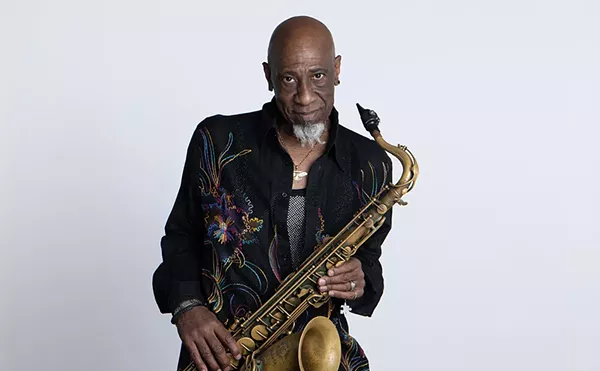
Audio By Carbonatix
[
{
"name": "GPT - Leaderboard - Inline - Content",
"component": "35519556",
"insertPoint": "5th",
"startingPoint": "3",
"requiredCountToDisplay": "3",
"maxInsertions": 100,
"adList": [
{
"adPreset": "LeaderboardInline"
}
]
}
]
James Bond’s movie run turns 40 this year with his 20th adventure, Die Another Day. Of course, 40 is a milestone, a marker for middle age and a presumed warning that just over the hill lies a broken-down road that even a “double-0” superspy might find hard to negotiate — despite a supercar modified by MI6’s technical wizard, Q.
Damn the fantastic, high-tech weapons of mass destruction, the femmes fatales, and supervillains — Bond has evaded and vanquished them since he was just a young agent in evening wear. But what about the dimming of vision, arthritic action and even a type of cinematic erectile dysfunction to which an aging series like Bond’s may be susceptible? Would 007 have the heart (or the stomach) to change with the times? With his own superior, M (Judi Dench), putting him down as “an anachronistic dinosaur” in Pierce Brosnan’s first Bond film, GoldenEye (1995), XXX opening by essentially killing him in effigy, and Austin Powers satirically dancing on his grave, the answer seemed to be no.
But as in You Only Live Twice (1967), reports of Bond’s death are greatly exaggerated. 007 catches a monster wave surfing into Die Another Day: It’s screenwriters Neal Purvis and Robert Wade’s (the team behind The World is Not Enough) answer to XXX, and their story continues to follow suit. Without giving too much away, they practically crucify her majesty’s loyal, 20th century bulldog (imprisoned and tortured thousands of miles from his barber, Bond becomes the popular image of Jesus Christ) and resurrect him into a clean-shaven, new-millennium rebel — but one with sophistication, and more mature poise and sex appeal than XXX.
But Die Another Day goes above and beyond answering XXX’s back talk. Purvis, Wade and director Lee Tamahori (Along Came a Spider) have made a movie that does what many approaching middle age do: It reflects on the past. They play on postmodern variations of the Bond flick legacy. You could call it “triple G” for girls, gadgets and guns.
Emerging from the sea like a swimsuit model’s version of Venus, Halle Berry’s mysterious Jinx echoes the entrance of Ursula Andress’ Honey Ryder in the first Bond film, Dr. No (1962). Though she isn’t the first black “Bond Girl” (Roger Moore’s Bond bedded Grace Jones’ May Day in 1985’s A View to a Kill), Berry’s starring role reflects this era’s more racially inclusive aesthetic. And Jinx is more endowed in body, mind and skills (she delivers a climactic fight scene) than Ryder, raising the Bond Girl standard.
Q’s (John Cleese) workshop, now in an abandoned British tube tunnel, is littered with artifacts from the 40 years of 007’s missions. He shows Bond his new spymobile, an Aston Martin Vanquish replete with an ejector seat, as much armament as a helicopter gunship and state-of-the-art technology that can render it virtually invisible. Its lineage can be traced back to the spy’s more modestly equipped and armed Aston Martin DB5, which first rolled into her majesty’s secret service in Goldfinger (1964). The Vanquish is Die Another Day on wheels: Both car and film update elements of their heritage and are packed with high-tech power (this Bond flick employs more computer-generated imagery — mostly for its physically impossible stunts — than any before it).
Then there’s the supervillain, Gustav Graves (Toby Stephens), and his henchmen: Zao (Rick Yune), an all but indestructible North Korean soldier, and the dreadlocked Maori Mr. Kil (Lawrence Makoare), a tip of the hat to Goldfinger’s Oddjob. Graves is as much a nightmarish take on British billionaire entrepreneur-adventurer Richard Branson as the evil madman of Tomorrow Never Dies, Elliot Carver, was on billionaire media mogul Rupert Murdoch. But Graves is Bond’s first younger nemesis and is physically able to take him on one-on-one, as he proves in their fight scenes. And Graves’ character holds a huge climactic twist in store for all concerned.
007 turns 40 perhaps more potent than ever. Why? He may be our masculine and ironically materialist fantasy. Brosnan’s Bond struts down the street as if he not only owns the world, but he’s ready, willing and able to kick its ass — or kiss it. We love him for allowing us into his exclusive high life and hate the insanely wealthy madmen he fights: He allows us to share his rich cake and eat it too. Maybe that’s why we’ll let him die another day.
James Keith La Croix writes about film for Metro Times. Send comments to letters@metrotimes.com.





